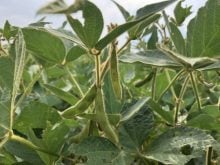Better cattle prices and a shortage of hay in some areas might be enough to drive some older ranchers toward selloff, but industry observers say herd dispersal is unlikely to match the stampede witnessed last year.
Heavy rainfall in Manitoba’s Interlake region and north of Dauphin, and continued dry conditions in the southwest have reduced available supplies of hay in the province, according to Manitoba Cattle Producers Association president Martin Unrau. But on the other hand, higher prices and strong barley yields across the province are putting the shine back on the cattle business.
Read Also

Fall rye hits record high in Manitoba
Winter cereals 2025: More Manitoba fields grew fall rye in 2025 than ever before, but winter wheat slipped and, while spring stand survival was good, drought took its toll
“There’s probably some older guys who might get out because of problems with haying and getting feed,” he said.
“But at least the prices look like they are going to be stronger. We don’t know what the final prices will be, but it definitely looks a lot more positive than last year for culling cows.”
With the U.S. Department of Agriculture’s latest report stating that the North American herd has shrunk by one percent, many cattle producers are starting to believe that the light at the end of the tunnel could be much closer than the 18 months forecast by some.
“I’ve been positive for the last year because the signals were pointing toward higher prices and a little more stability in the cattle industry. I think it’s here,” said Unrau.
“We might not see all the benefits until next spring or next fall, but I definitely think we are climbing out of the hole.”
Unrau, who operates a feedlot and farms near MacGregor, Man., recently harvested a 100 acre barley crop that was yielding about 95 bushels per acre. With a big crop being reported across many parts of the province, a spate of bad harvest weather could change the game for feed grain prices, he said.
“I think there might be a few crops around that might be a little bigger than people thought. With bad weather, there might be more feed around,” he said.
Rumors that U.S. country-of-origin labelling rules would send fall calf prices into a nosedive never materialized, he added.
“Those Americans are in the market just like they were before July 15. It hasn’t done a bit of damage to us,” said Unrau.
Robin Hill, a market analyst for Heartland Auction Service in Virden, Man., said optimism seems to have returned to the cattle industry after years of struggle, starting with the border closure in 2003, a Canadian dollar at par and then high feed grain prices last year.
As an indication of how things have turned around, some 900-pound steers sold last week brought $1.04 to $1.07 per lb., he said.
In the cow market, prices are only five to eight cents off pre-BSE prices.
“I think most guys will still keep their cows even though they were threatening to get rid of them,” said Hill, adding that dispersal sale bookings don’t tell the whole story.
“We’ve had a couple guys who have had their cows booked for three years in a row, and now they’ve got them booked again. They probably won’t bring them.”
So far this fall, the auction mart has booked five bred cow sales, with about 300 head per sale, he said.
Last year, they averaged two a week for the first three weeks of the season, and as many as three a week at the peak.
“There won’t be as many as last year, but that was the biggest year I’ve ever seen,” said Hill.
Lately, however, kill cows at 43 to 45 cents per lb. have been bringing more money in recent months than the bred cows brought at the dispersal sales last fall.
The feed supply situation, in the southwest at least, might not be as bad as reported, said Hill, with second-cut alfalfa showing reasonably good yields.
“Things can change, but three weeks ago we thought these calves would be worth just about nothing. I’m not saying there’s going to be a profit in them, but they’ll be worth some money,” said Hill.
Michael Buchen, a business development specialist for finished beef with Manitoba Agriculture, said a three to six percent reduction in the province’s cow herd is likely this fall.
The pessimistic figures that have been tossed around lately, that anywhere from 10 to 30 percent of producers would sell off their herds this fall, don’t jive with reality.
With 600,000 cows in the province, for even 10 percent of producers to exit during the 12-week run in the fall, 1,000 cows per business day would have to be sold.
“I don’t see that, to tell you the truth,” he said. “People tend to get a little overly rambunctious with their talk.”
Just how much fortunes have changed was evident at a sale last week in Ashern, Man., he said. The average price for the 189 cull cows was $667 per head, while the 23 bulls averaged $1,239.
“The culls are worth a lot of money. We’ve been killing cows way above the last two year average and now we’ve got most of these older cull cows cleaned up,” he said.














